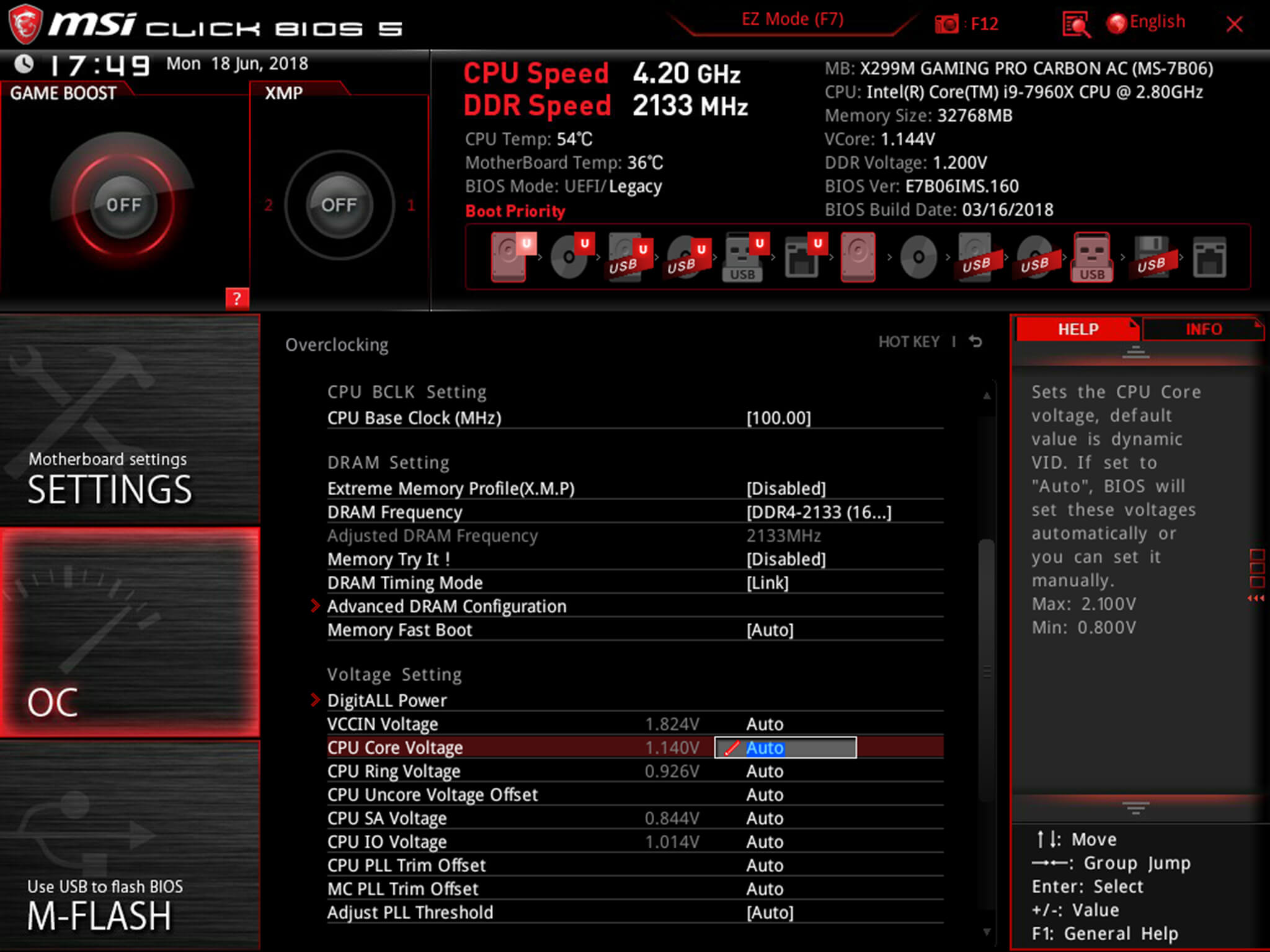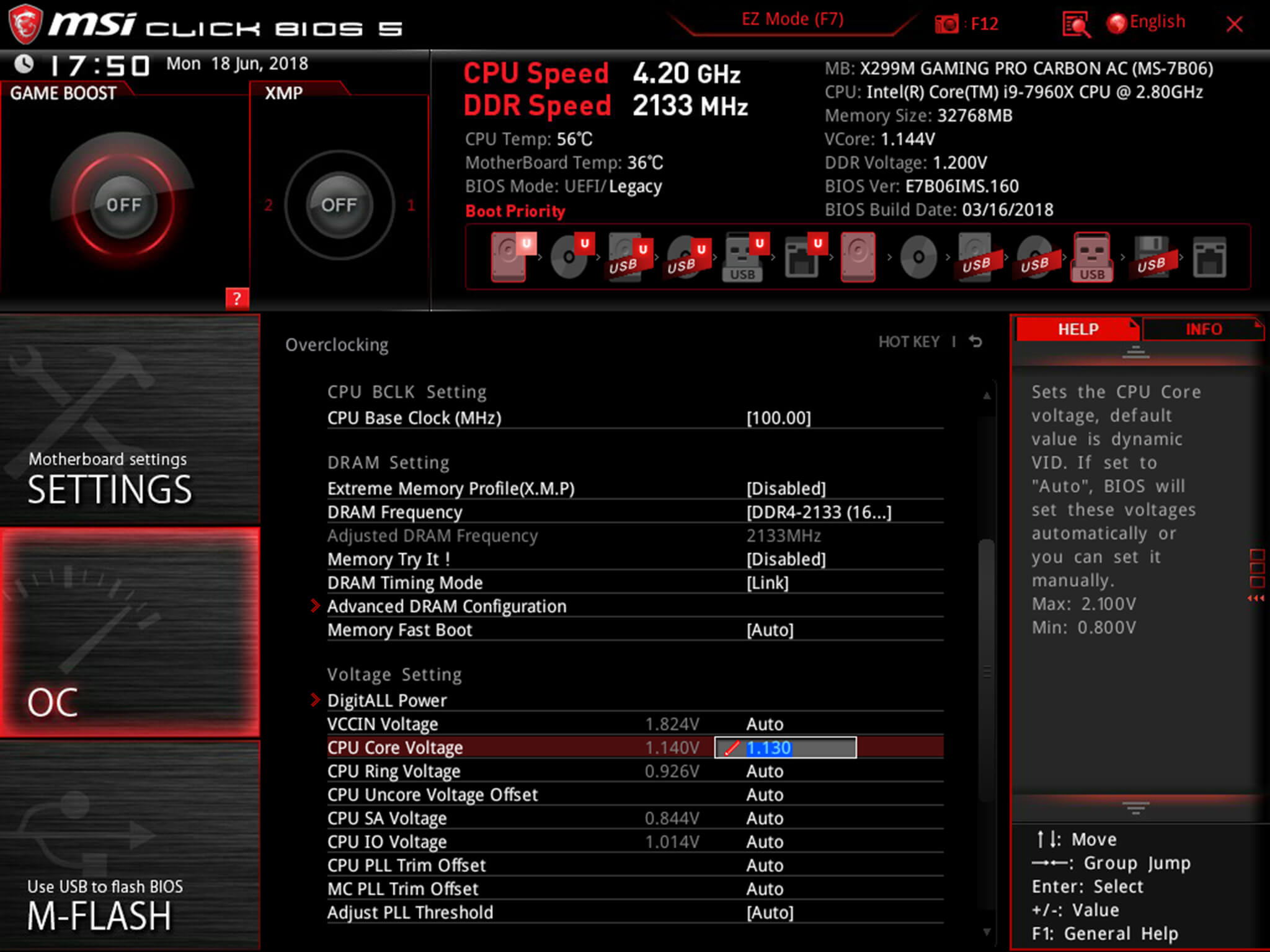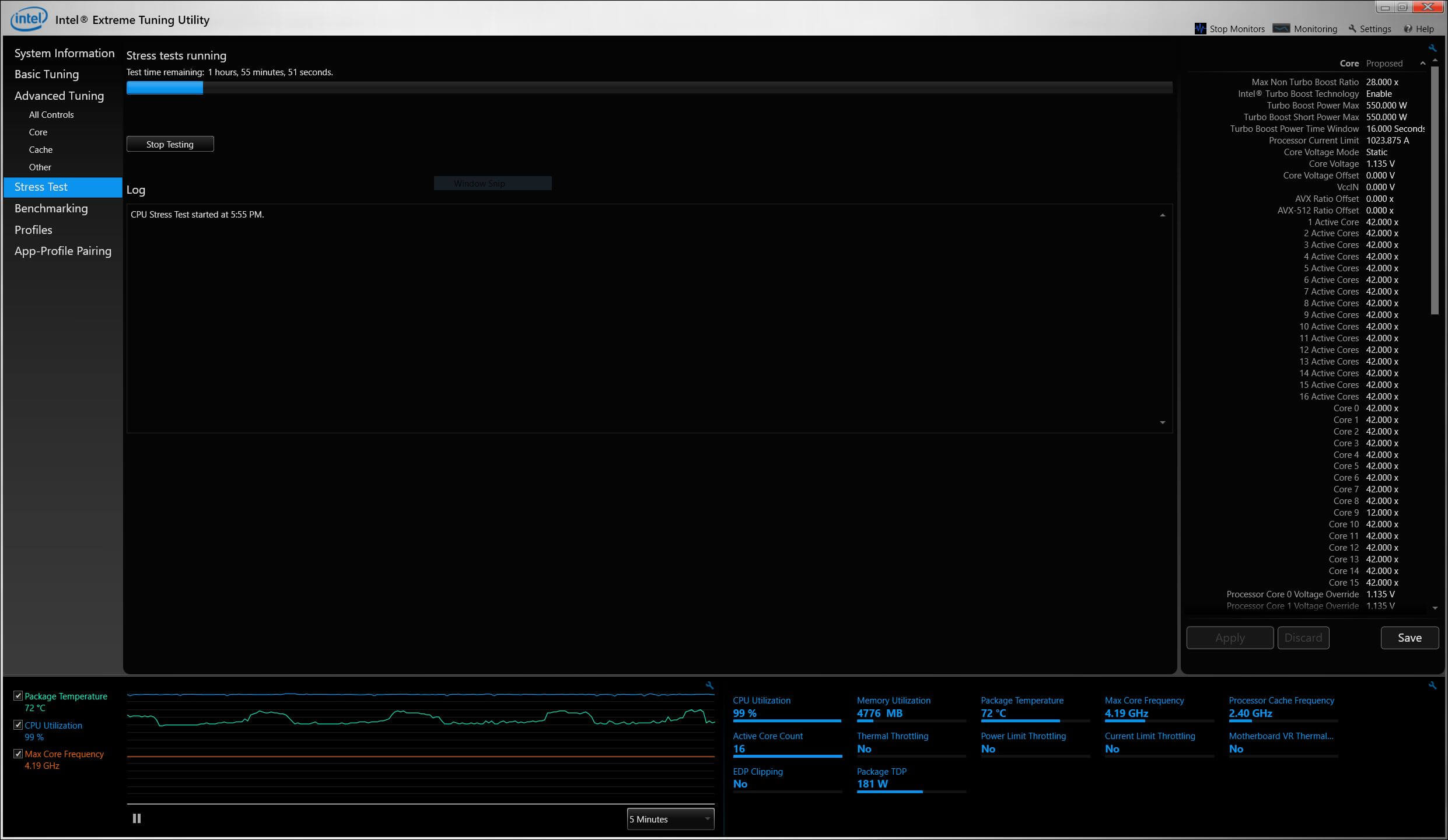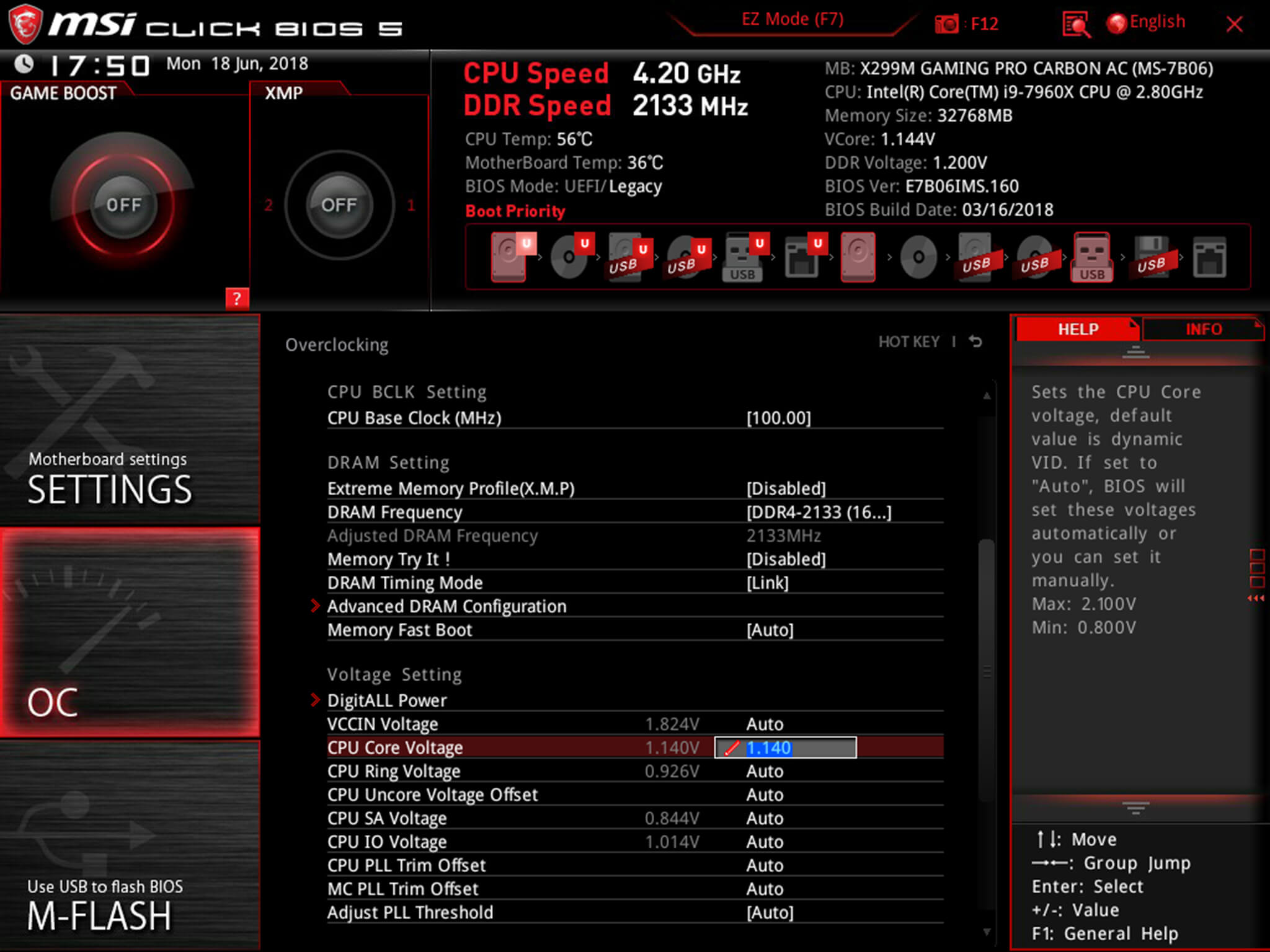The core voltage is different for each processor model, and while all CPUs of the same model have the same VID, not all samples maintain stability at the same clock speeds and Vcore due to slight variations in silicon quality. Every sample of the same CPU model is tested to maintain stability at the default speeds and the VID determined by the manufacturer.
Core voltage typically maintains a constant value while your CPU is in use; however, sometimes under heavy workloads vcore can fluctuate. This is known as Vdroop and can be corrected with load-line calibration. This applies additional voltage as load increases to maintain your CPU's stability.
When it comes to overclocking, you can only push your CPU's frequency so far before your CPU starts to experience instability. Programs might begin to crash or hang up, game performance could suffer or your computer could even fail to boot. This is because your processor isn't getting enough voltage to maintain system stability.
Increasing voltage will allow you to dial in the perfect overclock.
To adjust the voltage, you'll need to boot into your motherboard's BIOS and make adjustments there. The Vcore is expressed as a three decimal value, such as 1.235v. By default, the voltage control is set to auto; this can be overridden by typing in any value. Make sure not to exceed the recommended maximum for your processor.

Before fine-tuning the Vcore, it's important to find a good baseline value for a given speed. This varies from model to model but it can be helpful to read reviews for your CPU, specifically ones that focus on overclocking.
Most publications will list the voltage they required to keep several different speeds stable. Every CPU sample is different and you will need to fine-tune the voltage before calling it done; however, these values do provide a good starting point.

If you boot your machine and don't find any stability issues, then you know it's time to start decreasing the voltage. When overclocking, you want to find the lowest voltage required to maintain stability. More voltage equals more heat and this will allow you to keep temperatures under control.

The safest way to adjust voltage is with increments of .01 volts. Decrease voltage until your computer starts showing signs of instability under load. Use a program like Intel's Extreme Tuning Utility (XTU) or Prime95 to stress test your processor.
If the test fails or crashes, then you need to raise the voltage back up to the previous stable point. For optimal efficiency, you can increase the voltage by .005 instead and again test for stability.

Conversely, if your overclock isn't stable at your baseline voltage, you will then need to increase the voltage until your computer shows no adverse effects and then decrease in increments of .005 to fine tune.

Overclocking is not the only time it can be useful to adjust voltage. As mentioned, higher voltage levels cause your CPU to generate more heat, regardless of frequency. Some CPU samples may have a higher VID than is actually required at the default frequency. Undervolting your processor allows your to maintain stability while decreasing temperatures and extending the life of your processor.
It's a common misconception that disabling Turbo Boost is a more effective substitute for shedding heat. While this does result in decreased temperatures, it is not an alternative as the purpose of undervolting is to maintain the same level of performance while generating less heat. When making adjustments, the same principles apply here as with overclocking, decrease Vcore in increments of .01 and then fine tune with adjustments of .005.
 The cicadas aren't invading the U.S.
The cicadas aren't invading the U.S.
 Hulu is coming to the Nintendo Switch eShop this week
Hulu is coming to the Nintendo Switch eShop this week
 IRS targets Coinbase users in an attempt to thwart tax fraud
IRS targets Coinbase users in an attempt to thwart tax fraud
 Reddit bans board where men posted misogynistic content and even advocated rape
Reddit bans board where men posted misogynistic content and even advocated rape
 Best robot vacuum deal: Get the Shark Matrix Plus 2
Best robot vacuum deal: Get the Shark Matrix Plus 2
 Amazon investigating Jeffrey Tambor over sexual harassment allegation
Amazon investigating Jeffrey Tambor over sexual harassment allegation
 We're losing our eyes on the rapidly warming, melting Arctic
We're losing our eyes on the rapidly warming, melting Arctic
 Here's exactly how fast the iPhone X battery charges up
Here's exactly how fast the iPhone X battery charges up
 Drake tests out new untitled song during his world tour
Drake tests out new untitled song during his world tour
 That $1,000 iPhone X actually costs about $370 to make, report claims
That $1,000 iPhone X actually costs about $370 to make, report claims
 Your star sign actually determines how you use your iPhone, trust us
Your star sign actually determines how you use your iPhone, trust us
 Twitter must fix verification, but there are no easy solutions
Twitter must fix verification, but there are no easy solutions
 Here's exactly how fast the iPhone X battery charges up
Here's exactly how fast the iPhone X battery charges up
 Humvee maker is suing Activision for using the cars in 'Call of Duty'
Humvee maker is suing Activision for using the cars in 'Call of Duty'
 Google: Project Loon has provided internet to 100,000 in Puerto Rico
Google: Project Loon has provided internet to 100,000 in Puerto Rico
 Best rope light deal: Save 25% on Lepro N1 AI Smart RGB LED Strip Lights
Best rope light deal: Save 25% on Lepro N1 AI Smart RGB LED Strip Lights
 Another racist account gets verified on Twitter
Another racist account gets verified on Twitter
Google's moonshots appear not so crazy now as company proves its worth beyond mobile adsBernie Sanders' digital team offers a way for people to call the White HouseGreat white shark gracefully photobombs 10CNBC's Trump tweet alert is a new level of absurdTwitter is burying Moments as it bets on live videoNvidia and AMD Keep Dropping GPU Prices After New Product Launches FlopNvidia and AMD Keep Dropping GPU Prices After New Product Launches FlopTrump is going to build that damn wall and all people can talk about is avocadosTrump's voter fraud investigation may want to start with his own daughterInfuriating Valentine's card is the sweet, sweet revenge singletons needUPDATE: FBI Director James Comey is no longer coming to Austin to narc on your SXSW funIn their own words: What 'Invasion Day' means to a rural Indigenous communityFacebook just hired a big shot to run its virtual reality divisionThe 8 'CounterThat kid who said 'screw our president' is apparently Drew Carey's sonNvidia and AMD Keep Dropping GPU Prices After New Product Launches FlopTrump's voter fraud investigation may want to start with his own daughterTrump's voter fraud investigation may want to start with his own daughterIn their own words: What 'Invasion Day' means to a rural Indigenous communityThe downside of a bionic penis? A two Cooking with Dante Alighieri by Valerie Stivers Cambridge Diary, 2014 by J. D. Daniels Our Summer Issue Poets Recommend by The Paris Review Jay Duplass talks Hades' big introduction to 'Percy Jackson and the Olympians' Passing Through: On Leonard Cohen by Andrew Martin 'Palworld' on sale: Save 10% on Steam until Thursday at 1 p.m. ET For the Record, the Review Has Not Abolished Fiction by The Paris Review Apple Vision Pro scalpers are making a killing. Here's why. Snapchat+ is reportedly introducing an AI Bitmoji pet On Cary Grant, Darryl Pinckney, and Whit Stillman by The Paris Review Infinite Dictionaries: A Conversation with Marc Hundley by Na Kim Wordle today: The answer and hints for January 24 It's not just eBay: 5 other tech companies with brutal layoffs Best Garmin deal: The Garmin Venu Sq smartwatch is under $120 at Amazon Cooking with Cyrano de Bergerac by Valerie Stivers Other People’s Partings by Peter Orner 4 really weird things you can do in 'Palworld' A Laborer Called a Writer: On Leonard Cohen by Carina del Valle Schorske Apple just made a major investment in Chinese wind power If Kim Novak Were to Die: A Conversation with Patrizia Cavalli by Annalena Benini
2.1552s , 10133.59375 kb
Copyright © 2025 Powered by 【Dear Utol (2025): Pa-Yummy si Ma'am Episode 37】,Fresh Information Network